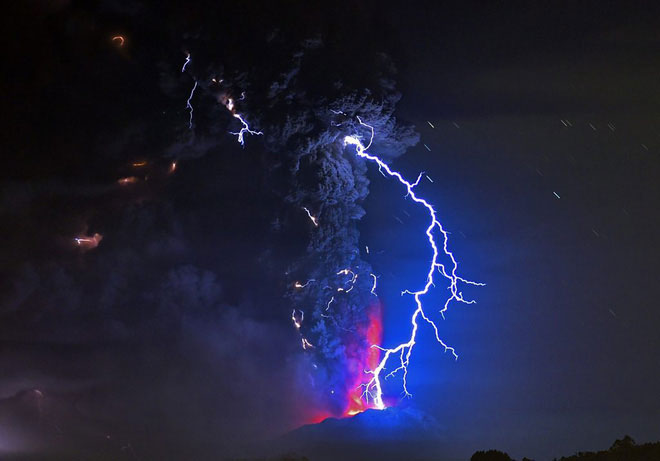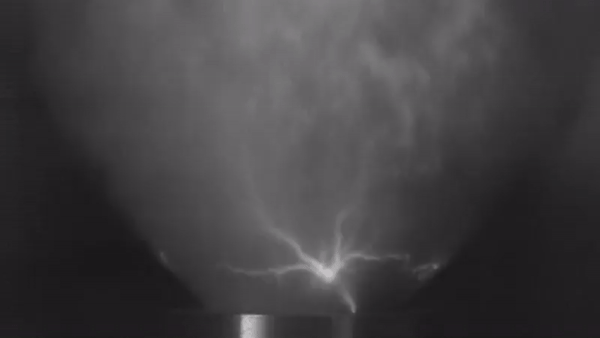Experimenting with 13,000-year-old ash and ash, scientists investigated why volcanic lightning formed
On this Earth, there are few beautiful phenomena that are as dangerous as volcanic lightning: a huge pillar of smoke erupts from the mouth of a large mountain , volcanic dust particles collide with each other to create. static electricity will create the scene of a fantasy story with dragons and magic.
We are interested in volcanic lightning , science is looking at this natural phenomenon with a curious gaze: how did volcanic clay form? Although they already knew the role of dust particles, the truth was clearly not that simple. That's why all along, scientists have been trying to create volcanic lightning in the lab.

Volcanic lightning - beautiful natural phenomenon.
The latest success is probably the attempt to produce results that are closest to reality. In the study, published in Geophysical Research Letters, the scientists wrote that they were able to change the properties of volcanic haze , changing the temperature of the smoke as well as the density of the smog can decide the Success or failure of volcanic lightning.

It seems that dry dust is the key to creating the natural wonders of mankind.
This experiment is not simply about curiosity and finding ways to create volcanic lightning for fun: volcanic lightning is the way we can detect volcanic eruptions from afar. The more we know about how a volcanic lightning is born, the easier it is to determine exactly what type of eruption is taking place, in order to minimize the work burden for air traffic control as well as save the lives of communities. the last living wind.
Sönke Stern, a volcanic clay researcher at Ludwig Maximilian University and the lead author of the new study, understands the contributions he makes to humanity in general and science in particular. However, he also told Gizmodo like this: ' To be honest, every day I sat there exploding that pile of stones made me very happy .'
Similar to lightning in thunderstorms, volcanic clay also possesses a key element: a clear separation of positive and negative charges . When the physics were unable to keep both sides of the charge separate, lightning would appear, tearing the insulating air film.

Volcanic lightning should clearly separate positive and negative charges.
The composition of the smoke column of volcanic clay is also different from ordinary clouds: the main factors that make up the smoke are volcanic ash. ' We are pretty sure that friction particles have caused electrical contamination, ' said Alexa Van Eaton, a volcanic researcher from the Cascades Volcanic Observatory at the US Geological Survey.
The collision of dust particles is an example of friction producing electricity - or . friction electricity. Researchers know this during field surveys, because then they can see firsthand the phenomenon they are trying to explain. Researcher Cassandra Smith, also at the Cascades Volcanic Observatory, said to Gizmodo: ' Field surveys are important. '
Sadly, ' you never know what a volcano will do ,' said Ms. Smith. It is too difficult to track real-world volcanic lightning phenomena , because you know, surrounded by a thunderstorm is extremely hot dust gushing out from one of the most difficult environments on Earth. Fortunately, we have a lab environment to study.

It is too difficult to monitor the real-life volcanic lightning phenomenon.
Ludwig Maximilian University is one of the few places where a laboratory can reproduce volcanic eruptions in the most realistic and accurate way. Besides, they can also create lightning in the laboratory. At the lab, the most frequent name is Corrado Cimarelli, a volcanic expert and new co-author of the study.
In the latest test, they use an experiment called ball bombs: a compartment of compressed argon gas and ashes will explode when a certain pressure limit is reached, firing gas into a steel chamber. Smoke will spew out at an enormous rate, and from there volcanic lightning forms. Thanks to the temperature from the furnace, the ash can reach over 300 degrees Celsius.
The test ash was not fanning or anything else, it was what was left from an eruption 13,000 years ago of the volcano (now dormant) Laacher See. The team was fortunate to receive 300 kg of ash from a quarry company operating near the volcanic area.
The team of scientists found that: at room temperature, lightning strikes are larger but appear less; the higher the temperature, the weaker the lightning strength will be, the denser the appearances will be. Although they know that temperature plays a big role, they are not clear how the law of clay is formed and what is the role of the volcanic lightning.
The effect of the new water is most obvious: just a little bit of volcanic ash ash, the electrostatic ability of the ash combination drops several times. When the ashes were damp enough to the point, no lightning appeared. They put their hands on their foreheads again to wonder why.
After several tests, the team discovered that the water vapor emitted at a speed much faster than argon gas, creating a bigger explosion, increasing the size of the cloud of ash that scattered the fly ash. So ash does not have the opportunity to friction with each other to create static electricity. Conversely, the more dry the ash, the more volcanic clay will be.

As long as the volcanic ash is a bit damp, the electrostatic capacity of the ash assembly is reduced several times.
In real life, there is still very little data from surveys showing that moist ashes produce less clay. It's not clear why, but there's a truth like this: if adding water to the hot magma, the explosion will happen much stronger. It's not clear what the difference is between 'water + magma' and 'water + ash' , but most likely when magma is wet, the ash will be less likely to collide with each other and generate electricity.
Dry ash , on the other hand, makes electricity much easier . According to Stern, the ash itself is an inefficient insulator, so the particles are self-contained, grabbing their charge selfishly, and can only be discharged during a collision. and create lightning.
What comes out of the experiment gives science a much better understanding of how volcanic lightning is formed. But Smith also stressed that it is difficult to isolate individual factors that influence volcanic lightning, even under tightly controlled laboratory conditions. That is, it is impossible (or at least not yet) to clearly identify which factors are causing volcanic lightning.
And the experiment only investigated the phenomenon that occurred in the lower part of the smoke column . When volcanic ash flies high enough, it is the ice particles that cause volcanic lightning. ' The sky above is an entirely new, unexplored volcanic ash kingdom, ' said lightning researcher Van Eaton.
Volcanoes that observe volcanoes may be blocked by clouds. Besides relying on volcanic clay to analyze, we have no other way to identify the nature of the ash mass emitted from a volcanic eruption. The dust emitted from an 'awakening' volcano can drag planes, devastate homes, pollute water sources and directly affect human health, so know the nature of ashes will help us a lot.
The more we know how ash is (through the observation and analysis of volcanic clay created from the huge ash), the more we understand what the deadly smoke carries in us.
But it is also difficult to discern the importance of the research, and it is not at all doubtful of the motives of the team of scientists. Indeed, volcanic lightning is a 'cool' phenomenon, if given the chance (with a closed laboratory and 300 kg of 13,000-year-old ash and ash), we will also sit all day creating volcanic lightning. just for fun.
Fortunately, scientists, with the ability to study closely what happens in a cloud of dust, have these experimental instruments in their hands. The greater the power, the more responsibility, an uncle named B. My often say this sentence.
- Admire the phenomenon of lightning in extremely rare volcanoes
- The terrifying scene when lightning struck . volcano
- Interesting things about lightning
- Lightning flashed on the erupting crater in Japan
- Terrifying spectacle when lightning hit ... volcano
- The easiest lightning strikes that you have to remember
- Admire the phenomenon of extremely rare volcanic lightning
- Harm of lightning and how to avoid lightning
- Japanese volcanic island is 10 times bigger
- Modifications of the human body after being struck by lightning
- New islands appear in Tonga after the volcanic eruption
- The 13-year-old boy talked about the shocking feeling after being struck by lightning
- Breathtaking spectacle
- The first time recorded the mysterious volcanic thunder
 'Fine laughs' - Scary and painful torture in ancient times
'Fine laughs' - Scary and painful torture in ancient times The sequence of numbers 142857 of the Egyptian pyramids is known as the strangest number in the world - Why?
The sequence of numbers 142857 of the Egyptian pyramids is known as the strangest number in the world - Why? History of the iron
History of the iron What is alum?
What is alum?